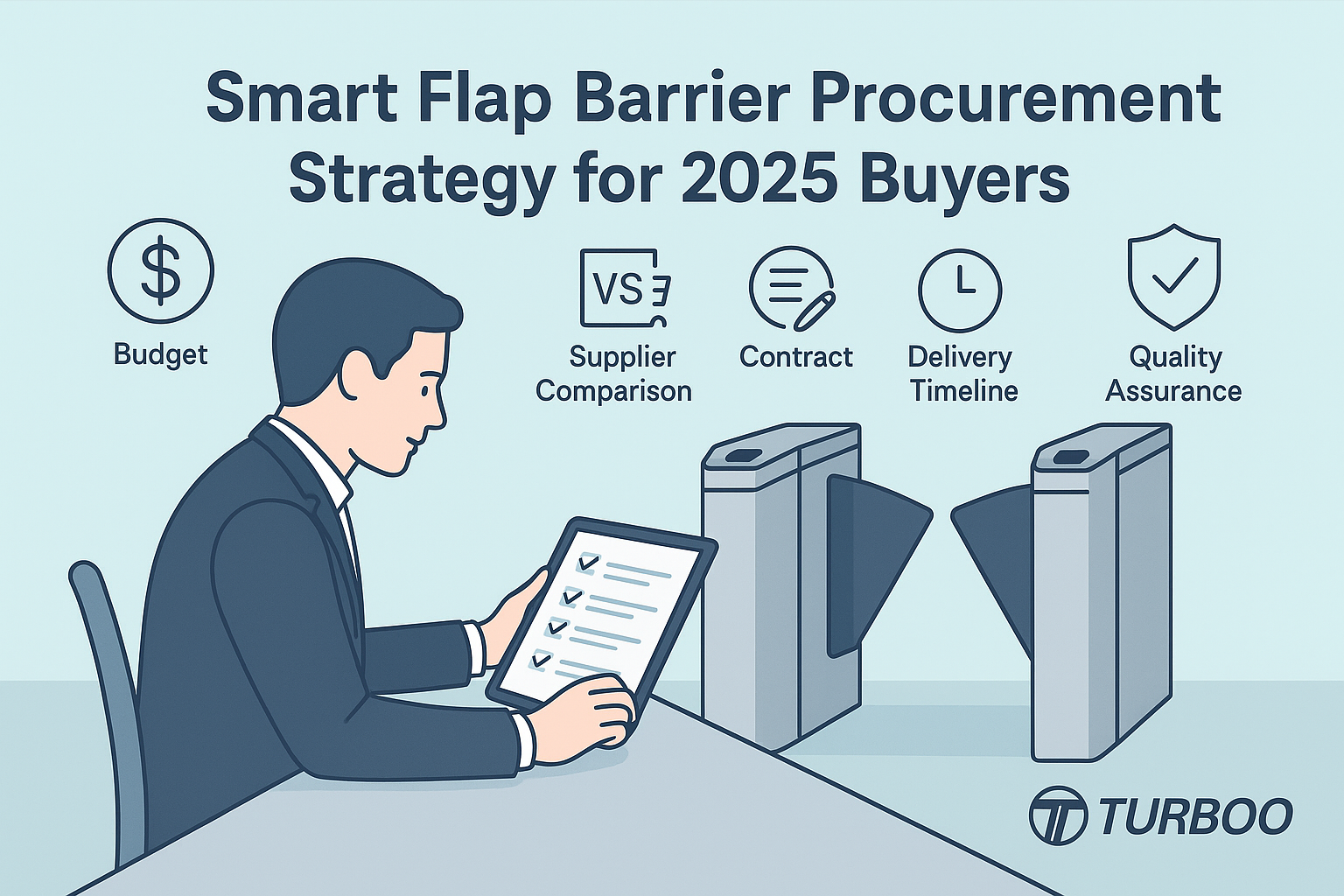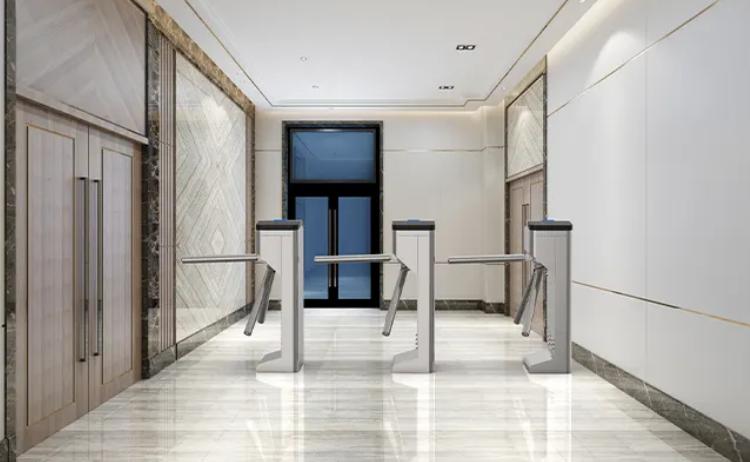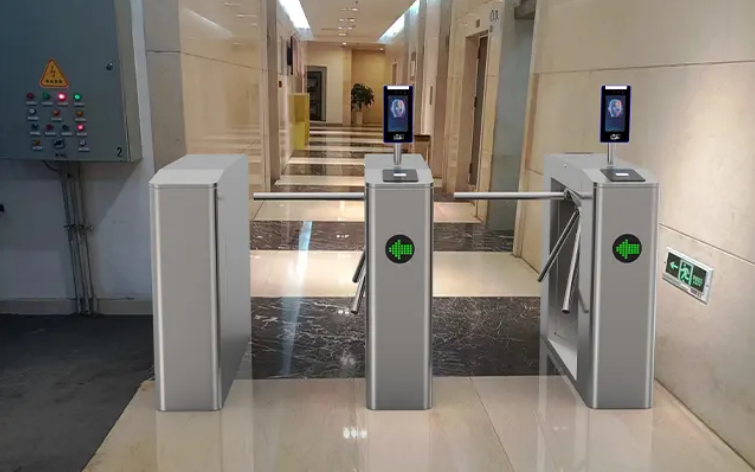Smart Flap Barrier Procurement Strategy for 2025 Buyers


Organizations today are stepping into a future where physical security must match the pace of digital transformation. In 2025, the landscape for access control is no longer about basic turnstiles or single-function entry gates. It’s about intelligent, connected, and scalable infrastructure that aligns with operational goals, security compliance, and user experience expectations. Yet many procurement teams are still relying on outdated methods—sourcing flap barriers based solely on upfront cost or legacy vendor relationships.
This disconnect is costing organizations more than money. It leads to fragmented systems, underutilized features, integration headaches, and missed opportunities for long-term savings and smarter operations. As modern environments become more adaptive—embracing hybrid work, biometric authentication, and AI-driven surveillance—a traditional approach to access control simply won’t keep up.
A smart flap barrier strategy for 2025 considers more than product specs or unit pricing. It factors in compatibility with evolving IT ecosystems, resilience to changing regulations, modular upgrade pathways, and cross-functional coordination. Buyers are under pressure to future-proof their access systems—not just for 2025, but for years beyond.
This guide empowers buyers to align their procurement practices with what modern infrastructure demands. From evaluating vendors for strategic agility to building a procurement roadmap that supports long-term performance, the sections ahead provide a grounded framework for making confident, forward-thinking decisions.
The Rising Complexity of Access Control Infrastructure
What used to be a simple transaction—buying a mechanical or motorized gate—has become a strategic IT and facilities investment. Today’s flap barrier systems are more than passageways; they are connected nodes in a broader access control infrastructure. They gather real-time data, enforce behavioral protocols, and integrate with enterprise identity systems. This functional expansion introduces a level of complexity that outdated procurement models are ill-equipped to manage.
Modern access control now intersects with cybersecurity. Barriers might be linked to badge readers, biometric scanners, or mobile apps. Some even support thermal sensors or AI-based behavior analysis. These integrations require careful planning, compatibility verification, and the ability to manage firmware over time. Buyers must think like systems architects, not just equipment shoppers.
Furthermore, flap barriers now play a role in broader organizational goals—like ensuring health compliance, optimizing user flow, or contributing to smart building operations. Procurement teams that ignore this broader context risk choosing hardware that lacks the capacity to evolve with their ecosystem.
In 2025, the most effective buyers are those who approach access control as a part of digital infrastructure, not just a piece of hardware. This perspective reframes every procurement step—from vendor selection to integration, to long-term service planning.
Evaluating Vendors Through a Future-Ready Lens
In 2025, vendor selection should be treated as a strategic partnership decision—not a cost-driven purchase. Gone are the days when choosing the lowest bidder sufficed. Modern buyers must look deeper, assessing how well a supplier aligns with future demands in technology, service, and compliance.
A smart flap barrier strategy includes evaluating the vendor’s roadmap. Are they developing solutions with modularity and software expandability in mind? Do they support standard integration protocols? Can they commit to service-level agreements that match your operational expectations? Vendors that treat access control as a commodity won’t be able to meet the agility and performance needs of a modern enterprise.
Buyers must also examine documentation practices. Does the supplier provide complete manuals, API libraries, integration guides, and lifecycle support policies? The absence of these materials can slow down IT coordination and create long-term maintenance gaps.
Transparency and upgrade support are key. Can the vendor demonstrate a history of delivering timely firmware updates? Are hardware components designed for plug-and-play upgrades or full replacements? A vendor’s willingness to plan for the future is just as important as their ability to deliver in the present.
Ultimately, strategic access control sourcing means choosing a vendor that is not only competent today—but reliable, transparent, and scalable for tomorrow’s challenges.
Choosing Technology That Scales
Scalability has emerged as a critical differentiator in flap barrier planning. In environments with multiple sites, phased buildouts, or seasonal traffic variations, choosing scalable technology avoids redundancy, delays, and cost bloat.
The ideal 2025 turnstile approach starts with modular design. Buyers should prioritize flap barrier models that support add-ons—such as new credential types, expanded access logic, or plug-in indicators—without requiring a full unit swap. This flexibility enables systems to grow or adapt in-place, preserving capital and minimizing disruptions.
Additionally, software compatibility must scale across locations and platforms. Whether a buyer is managing three facilities or thirty, centralized control is essential. Look for vendors who support cloud integration, dashboard-based management, and remote diagnostics. These features are no longer premium—they are expectations for modern deployment.
Open communication protocols also matter. Systems that rely on proprietary or closed formats limit future expansion and make cross-vendor coordination difficult. By contrast, barriers that support standard APIs and open field protocols allow IT teams to integrate them with new systems—like visitor management platforms or emergency notification systems—as business needs evolve.
Scalability is about more than adding lanes. It’s about planning your access system to grow without friction—technically, operationally, and financially.
Prioritizing Integration Flexibility
Integration is no longer a convenience—it’s a baseline requirement. In 2025, organizations expect flap barriers to interact with building automation platforms, HR systems, visitor databases, emergency management tools, and more. That means flexibility is a make-or-break factor in any serious flap barrier strategy.
At the hardware level, integration begins with reader compatibility. Whether your system uses RFID badges, mobile credentials, biometric scanners, or multi-factor authentication, the barrier must support seamless data transmission and user recognition. Modern procurement planning also considers future upgrades. Will the barrier accept new authentication formats without requiring controller replacement?
At the software level, buyers must ensure the flap barrier can communicate with existing access control systems. That involves API documentation, middleware support, and the ability to synchronize credentials across systems. For environments with strict compliance requirements—like financial institutions or health facilities—these integrations must meet audit and data security standards.
Touchless technology is also a growing trend. In a post-pandemic environment, organizations are turning to mobile authentication and proximity sensors to minimize physical contact. Barriers that can support Bluetooth, NFC, or QR-based credentials give buyers more flexibility to future-proof their operations.
When integration flexibility is ignored, it leads to patchwork systems, increased IT overhead, and higher long-term costs. A forward-looking procurement plan puts interoperability front and center.
Budgeting with Lifecycle and Upgrade Costs in Mind
In a strategic flap barrier strategy, price is just one part of the equation—what matters more is total cost of ownership (TCO). Many 2025 buyers have learned the hard way that the cheapest upfront bid can become the most expensive over time when factoring in installation challenges, service gaps, or early obsolescence. A truly smart procurement plan must consider the entire product lifecycle, including expected upgrades and support costs.
Start by asking vendors for a breakdown of both initial and recurring costs. This should include hardware, software licenses, installation, training, firmware updates, and maintenance plans. Determine whether the vendor’s pricing model is flat-rate, usage-based, or subscription-driven. Hidden costs often reside in areas like remote access configuration, control room integration, or required peripheral devices.
Don’t overlook upgrade planning. If the vendor is known for releasing frequent enhancements—such as faster processors, biometric expansion kits, or new access formats—ensure your system is modular enough to absorb them. A fixed-unit system that can’t evolve will age out far quicker, forcing premature reinvestment.
Also consider budgeting for staff training and administrative overhead. Modern flap barrier systems often come with analytics dashboards and event logs, which require operators and IT staff to be properly onboarded. Clarify whether the vendor includes this training or charges separately for support packages.
By viewing flap barrier costs as a long-term operational investment rather than a one-time purchase, procurement teams create budgets that reflect the true financial landscape—and avoid unpleasant surprises in the years ahead.
Designing for Multi-Site Procurement Consistency
For organizations with multiple facilities, campuses, or branches, flap barrier strategy must focus on standardization. Inconsistency between sites creates management friction, increases training demands, and elevates service costs. In 2025, buyers are expected to design procurement frameworks that promote uniformity without sacrificing local functionality.
Start with hardware standardization. Choose barrier models that can be replicated across all sites, with configurable options (e.g., flap length, finish type, credential reader) that match specific entry needs. A standard unit base allows economies of scale during ordering and simplifies spare part stocking.
Software and backend systems should also align across facilities. A centralized management system helps IT teams monitor access logs, push firmware updates, and support local operators—all without physically visiting each site. Vendors that support this level of centralization bring significant value to enterprise-wide deployments.
Documentation and process control are also key. Create procurement templates, site assessment forms, and installation checklists that can be reused at every location. This prevents knowledge loss between projects and ensures that site-specific adaptations don’t break overall system cohesion.
For growing enterprises or franchises, this approach also makes onboarding new sites faster and cheaper. Instead of treating each location as a standalone project, a multi-site strategy allows consistent, scalable expansion built on shared systems and policies.
Aligning with Emerging Technologies and Market Trends
Access control is evolving rapidly. New features, standards, and user expectations are being shaped by the broader technology landscape. Buyers who ignore this context risk deploying systems that feel obsolete just a few years after installation. A smart flap barrier strategy for 2025 must actively engage with these trends to stay relevant and competitive.
According to Gartner’s technology trends, emerging capabilities like AI-enhanced security analytics, contactless authentication, and edge computing are redefining what “smart infrastructure” means. Flap barriers are increasingly expected to interface with these technologies—triggering alerts based on behavior patterns, supporting zero-touch verification, or sharing data with centralized dashboards.
The integration of health-focused tools (such as thermal scanners or occupancy counters) into access systems is also reshaping barrier expectations. Even if your facility doesn’t need them today, selecting a platform that can accommodate such features ensures better preparedness for future compliance or policy shifts.
Energy efficiency is another growing trend. Buyers are evaluating systems not just by throughput or speed, but by their power consumption, standby modes, and overall environmental impact. As ESG considerations gain traction, procurement teams are being asked to justify how their infrastructure supports sustainability goals.
To future-proof your barrier procurement, you must study the broader market—not just the vendor catalog. A well-informed strategy weaves upcoming innovations into today’s requirements, setting the foundation for a longer-lasting, higher-performing solution.
Building a Resilient Supply Chain with Smart Procurement Tactics
Supply chain disruptions are no longer a rare event—they’re a constant risk. From component shortages to shipping delays, procurement teams in 2025 must embed resilience into every sourcing decision. A smart flap barrier strategy includes safeguards to maintain project momentum even in volatile conditions.
Begin with supplier risk evaluation. How diversified is the vendor’s manufacturing base? Do they rely on a single production facility or have fallback options? What logistics partners do they use, and what contingency plans are in place for shipment delays? The answers will influence how reliably your timeline can be met.
Next, ask for production lead times and historical on-time delivery performance. Many reputable vendors now share this information upfront as part of their smart procurement positioning. It signals transparency—and gives buyers confidence that the partner understands the stakes of large-scale, time-sensitive deployments.
Consider structuring your procurement in stages. Break the contract into production phases tied to site readiness, instead of ordering all units at once. This flexibility helps avoid inventory congestion and ensures that project setbacks at one site don’t stall progress elsewhere.
And don’t forget about local storage and staging. Having a well-organized logistics hub—especially for multi-site deployments—gives you more control over flow and reduces last-mile delivery pressure.
Smart sourcing is not just about choosing the right product—it’s about engineering a supply chain that can adapt, respond, and deliver in any condition.
The Importance of Cross-Functional Procurement Collaboration
Modern procurement doesn’t happen in a silo. Especially when sourcing advanced access control systems, collaboration between departments is essential to balance technical requirements, operational needs, and budgetary constraints. A smart flap barrier strategy integrates perspectives from across the organization.
IT teams need to validate system compatibility, network security protocols, and software integrations. Without their input, even the best flap barrier hardware can become a headache to implement or manage. Security teams, meanwhile, will define the real-world use cases—ensuring the barriers serve not just compliance goals, but practical enforcement of policies.
Facilities teams handle installation prep, electrical routing, and long-term upkeep. Their insight is critical when evaluating vendor support plans, training programs, and physical installation logistics. And finance needs to understand the long-term value of higher-quality systems—especially when comparing upfront costs against operational savings or risk mitigation.
Engaging these teams early creates alignment, prevents rework, and ensures your procurement strategy reflects the full spectrum of needs. For 2025 buyers, success comes not from selecting the best product in isolation—but from building the best solution in collaboration.
Sustainability and Energy Efficiency in 2025 Barrier Systems
Sustainability has transitioned from a corporate buzzword to a procurement benchmark, particularly as ESG reporting and green building certifications gain momentum. In 2025, procurement officers are increasingly expected to consider the environmental impact of access control systems—including flap barriers. Fortunately, the technology has matured to support energy-efficient, low-maintenance options that meet both operational and sustainability goals.
Flap barriers now come with energy-saving features such as automatic sleep modes, low-power standby operation, and energy-efficient motors. When comparing models, it’s essential to review not just power ratings but usage patterns. Barriers that support intelligent activation—responding only when a user is detected—consume less power over time and contribute to overall building efficiency.
Material selection also plays a role. Stainless steel with recycled content, low-emission manufacturing processes, and packaging reductions are all factors that forward-thinking vendors can include in their product documentation. Buyers should request sustainability datasheets or environmental product declarations (EPDs) to verify claims and align with internal procurement policies.
From a broader perspective, flap barriers can contribute to green building certifications such as LEED or BREEAM. Their role in optimizing energy use, managing occupancy, and reducing HVAC load through controlled access all support sustainability metrics. These indirect contributions make flap barrier procurement a relevant component of your organization’s environmental strategy.
As energy costs rise and compliance expectations grow, sustainability is no longer a “nice-to-have.” A smart flap barrier strategy incorporates these values, not just for ESG scores—but for long-term operational efficiency and public accountability.
Leveraging 2025 Insights and Buyer Resources
No procurement decision exists in a vacuum, especially when planning for a system as foundational as access control. In 2025, buyers have more resources than ever—white papers, buyer guides, trend reports, and planning tools—to refine their approach and make smarter decisions. Leveraging these assets is a hallmark of an informed, strategic buyer.
Start with foundational knowledge. Resources like the flap barrier procurement tips provide proven insights into vendor evaluation, risk management, and contract structuring. These tips are not theoretical—they’re drawn from real deployments and vetted by industry practitioners.
Next, consult the flap barrier guide. It offers structured comparison points for different models, feature sets, and usage environments. This is especially helpful when evaluating trade-offs between budget and capability or aligning multiple stakeholders with varying priorities.
For trend alignment, the trends 2025 page delivers curated data on emerging technologies, customer expectations, and market direction. Knowing where the industry is headed gives buyers a competitive edge—not only in product selection but in negotiation strategy and long-term planning.
By continuously absorbing new knowledge, buyers transform from reactive purchasers into proactive planners—ensuring that each procurement cycle is smarter than the last.
2025-Ready Flap Barrier Strategy Checklist
- Define Long-Term Goals: Identify access control needs for today and future expansions.
- Evaluate Vendor Roadmaps: Ensure alignment with future technologies and service expectations.
- Standardize Across Sites: Use common models and protocols to simplify management.
- Prioritize Integration: Confirm compatibility with mobile credentials, biometrics, and IT platforms.
- Budget for Lifecycle: Include training, maintenance, and upgrade costs—not just hardware.
- Factor in Sustainability: Choose energy-efficient, low-impact products aligned with ESG goals.
- Negotiate Smart Contracts: Lock in SLAs, upgrade paths, and service flexibility.
- Build Internal Consensus: Collaborate with IT, security, facilities, and finance from day one.
- Stagger Deliveries Strategically: Align procurement with construction phases and installer capacity.
- Use Trusted Resources: Reference expert guides, trend reports, and case studies to guide decisions.
FAQs
Q1: What defines a smart flap barrier strategy in 2025?
It’s a forward-looking procurement approach that emphasizes integration, scalability, lifecycle planning, and alignment with broader operational and sustainability goals.
Q2: Are flap barriers customizable across different sites?
Yes, many vendors offer configurable options to suit local needs while maintaining core consistency in design and function.
Q3: How important is integration in today’s access control planning?
Critical. Without seamless integration, flap barriers cannot operate within the broader IT or security ecosystem effectively.
Q4: What’s the biggest mistake in modern flap barrier procurement?
Focusing only on upfront price. Long-term success depends on total cost of ownership, vendor support, and future readiness.
Q5: How can I ensure my vendor is future-proof?
Ask about their product roadmap, upgrade policies, compatibility with emerging standards, and client case studies that show sustained performance over time.












